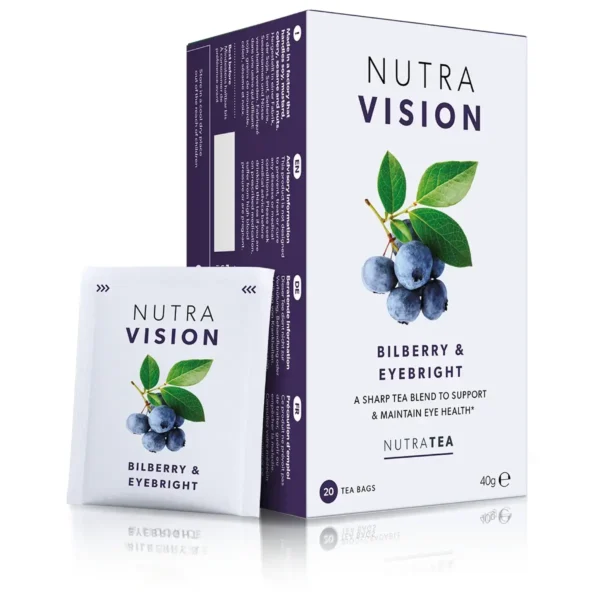SLEEP & RELAXATION IMMUNITY & ANTIOXIDANT VITALITY & INFLAMMATION ANTIOXIDANT & DIGESTION ENERGY & CLARITY WELLNESS & BLOOD SUGAR RESPIRATORY & IMMUNITY PREMIUM & FLAGSHIP BLENDS FLAGSHIP TEAS PREMIUM BLENDS PREMIUM & FLAGSHIP BLENDS PREMIUM & FLAGSHIP BLENDS PREMIUM BLENDS TEA MUGS, CADDY & BUDDY
8 Easy Ways to Relieve Tired Eyes

Too much time on screens can leave our eyes tired, itchy, and irritated. Learn how to relieve tired eyes in our latest blog post.
—
Our digital lifestyles mean that many of us spend a good chunk of the day looking at screens – whether that’s our phones, computers, or the TV.
However, all this time spent on screens can leave our eyes feeling tired and strained at the end of the day. 77% of adult workers say that they experience eye strain at the end of the working day.
As well as tired eyes, the symptoms of digital eye strain include:
- Dry eyes
- Irritated and red eyes
- Blurred vision
- Sensitivity to light
- Difficulty changing focus
- Headaches
- General eye discomfort
While life without screens is now almost unimaginable, there are things we can do to relieve tired eyes and reduce or prevent digital eye strain. Here are our 8 top tips for soothing tired eyes.
1. Apply a Warm Cloth
If your eyes feel tired, dry, and itchy at the end of the day, applying a warm compress can help to ease the discomfort.
The heat helps to encourage blood flow, stimulate the oil glands, and relax the muscles around the eyes. The warmth can also be very soothing and can help to restore moisture if your eyes are feeling dry.
Just take a clean washcloth and soak it in water. The water should be warm but not boiling hot. Wring out the washcloth until it is just damp, then fold it up and place it over your eyes for a few minutes.
2. Take Breaks
One of the reasons our eyes get strained when we’re working with screens is that we blink less often than we should. To combat this and protect our eyes from getting too dry, we need to take regular screen breaks.
You might have heard of the 20-20-20 rule – after 20 minutes of screen time, look at something that is at least 20 metres away for at least 20 seconds.
We should also take longer breaks every couple of hours. Take at least fifteen minutes away from screens entirely to allow your eyes a rest.
3. Adjust Screen Settings
We can also take some of the burden off our eyes by adjusting the settings on our devices to make working on screens less of a strain.
Turn down the screen brightness and make the text larger so that your eyes don’t have to work as hard to focus.
Positioning the screen correctly can help too. Make sure the screen is at least 50 cm away from your face (adjust the display settings if you need to so that it is still easy to read text and see images).
4. Consider Your Environment
Ideally, you should be working in a room that is brighter than your screen to help your eyes cope with looking at screens for longer. Adjust the lighting and close any curtains to reduce glare on the screen, which can make it harder for your eyes to focus.
If you are struggling with dry eyes, you could place a humidifier near where you sit. This helps to keep the air around you moister, which can reduce eye dryness too.
5. Use Blue Light Filters
Glasses with blue light filtering lenses and filters for screens are becoming increasingly popular. They partially block the blue light that comes from screens and devices.
This blue light is linked to eye strain. Over time, high levels of exposure to blue light could lead to damage to the retina and contribute to vision issues as we get older
By blocking some of this blue light, glasses and screen filters may help to reduce the symptoms of eye strain and relieve tired eyes.
6. Do Eye Exercises
Eye yoga may sound made up, but there’s some evidence to suggest that doing eye exercises regularly can help to reduce eye strain from looking at screens.
Eye exercises relax and strengthen the muscles around our eyes, encourage blood flow, and stimulate the blinking reflex – all of which help to relieve and prevent eye strain.
Like any form of exercise, eye yoga only works if you do it regularly.
7. Stay Hydrated
Another simple change you can make to protect your eyes from strain is making sure you drink enough fluids throughout your day. Being dehydrated can leave your eyes feeling dry, tired, and irritated.
Aim to drink 6-8 glasses or cups of fluid each day. This can be water, tea, coffee, or another sugar-free drink.
Which brings us onto…
8. Use Herbs
Certain herbs are known to support our eye health and help us avoid tiredness and irritation. Some of the most popular options include eyebright, bilberry, and green tea.
Although you can get these herbs as pills, extracts, and powders, we prefer to brew a delicious cup of herbal tea. Not only does this bring you all the goodness of the herbs, but it also helps you reach that goal of drinking 6-8 cups of fluid each day.
Our go-to herbal tea for eye health is NutraVision, a premium tea blend that includes eyebright, green tea, and bilberry.

